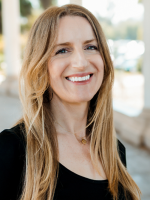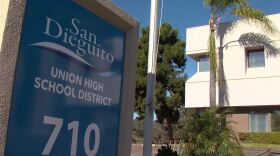ConnectArte at Trolley Dances:
- Sept. 28-29, 2024
- Two-hour tours leave hourly, 10 a.m. to 3 p.m.
- Old Town Transit Center, 4005 Taylor St., Old Town
- Performances/stops: Old Town Transit Center, Gaslamp Quarter, Seaport Village and Santa Fe Depot along the Green Line Trolley
- Tickets are required for the two hour trolley tours, but dance performances are public. $25-$40
Pamela Macías is a dancer, educator, choreographer and co-director of Tijuana contemporary dance studio ConnectArte, along with Matthew Armstrong and Raúl Navarro. The company has been tapped to create a work for San Diego Dance Theater's Trolley Dances, which takes place Saturday and Sunday Sept. 28-29.
Macías recently spoke with KPBS video journalist Matthew Bowler in ConnectArte's Tijuana studio between rehearsals and classes. When asked what it means to cross the border to create art and perform, Macías said that for her, dance is a way to break down barriers.
"(We're) not thinking about the border as a stop. It's more like a challenge to bring down the walls and try to connect. Because we are people. We are dancers. We are the same, and we have different languages, but for us, the movement is the language that we can continue to have that communication," Macías said.

Here's the rest of the conversation:
KPBS: Tell us about Trolley Dances — how you came to be part of it and what that means for you and your career.
Pamela Macías: So, for us, this was really important, because we got invited to be part of this year's Trolley Dances. And we have been doing some exchanges with San Diego Dance Theater, but we have never been invited to really be part of the Trolley Dances as choreographers — because some of us were dancing in some of the past events of Trolley Dances. But for now, it's really important to have that connection of being binational and have that exchange with San Diego and Tijuana, because that's one of the main purposes of ConnectArte.
KPBS: What was your experience with Trolley Dances before this?
Macías: Well, when we were starting ConnectArte, we already had some information because some of us participated as dancers before, so we got the full experience of going and being choreographed by some other persons, and to participate as dancers. And also, we have been experiencing going to the Trolley Dances and seeing the dances. For us, we were really excited to be invited as choreographers.
"I think Trolley Dancers is about the specific site that you have. So every dance, I think, is special and different because the space is different."Pamela Macías
KPBS: What kind of choreography have you seen in Trolley Dances before, and how are you going to put your spin on it?
Macías: So it's really fun because I think Trolley Dances is about the specific site that you have. So every dance is special and different because the space is different. So, I don't think there's any choreography that is the same. And I think we're really excited to work with the space, and also to work with the different dancers that we have, because we know that each of the dancers is really different. We really want to work with that, like to bring that unique style of each dancer, and to see the diversity of the dancers coming together.
KPBS: And how will you do that? What's the style — is this going to be more traditional ballet or contemporary? What can we expect?
Macías: Yeah, we're really going for the contemporary. We are specialized in contemporary dance. We dance many, many years in companies. And we're really trying to put our style of contemporary on the dancers, but also trying to know how to bring the spatial movement from them and really come together to the choreography.
"As soon as I took the first class, I just knew. Like, for me, it was about the connection that the other dances didn't bring to me. When I felt that connection with contemporary, I knew I wanted to do that. I didn't know how, but I knew I wanted to be a contemporary dancer."Pamela Macías
KPBS: So, when did you know you wanted to be a dancer?
Macías: Oh, wow. That's a really good question. I did ballet for many, many years, and as soon as I said I want to try something else, something different, I tried contemporary. I didn't even know what contemporary was or what to expect. But as soon as I took the first class, I just knew. Like, for me, it was about the connection that the other dances didn't bring to me. When I felt that connection with contemporary, I knew I wanted to do that. I didn't know how, but I knew I wanted to be a contemporary dancer.
KPBS: You've talked about dancing for many years, but you're not that old. What's the meaning of "many years"?
Macías: I mean, because for a dancer, it's like, you go fast. You know, our bodies are not getting younger, so? Because in ballet, I was 10 years, like, from five years to my 15 years of life. So it was many years for me. And even then, I felt the pressure of feeling that structure I didn't like. So that's why I felt to try new things.
"(We're) not thinking about the border as a stop. It's more like a challenge to bring down the walls and try to connect. Because we are people. We are dancers. We are the same. And we have different languages, but for us, the movement is the language that we can continue to have that communication."Pamela Macías
KPBS: What does it mean for you to be a studio from Tijuana, crossing the border and dancing in San Diego. Does it carry any significance?
Macías: Yes, I think it's really important for us to have that communication of not thinking about the border as a stop. It's more like a challenge to bring down the walls and try to connect. Because we are people. We are dancers. We are the same. And we have different languages, but for us, the movement is the language that we can continue to have that communication.
I think it's really important because for us, from the beginning, we start with the space of ConnectArte. We think of having teachers from San Diego to Tijuana, and also bringing some of the experience of Tijuana to San Diego. So it really makes us really excited to be working and having this challenge to bring our movement to the other side of the border.
KPBS: Does this particular dance for Trolley Dances carry any personal significance?
Macías: Yeah. I mean, we're trying to do the process, as we said, like we're trying to really put the focus on how we are really excited to bring people together and to find connection, because for us, it's really important that, like, really find the connection with the dancers and with the dance. So we are trying to prove the significance of being different people from different parts. But coming together to one point to do the same thing that we love, that is to move. It's to dance It's to connect.
KPBS: How would you describe that internal experience or sensation of dance?
"Everything I can't say with words, I think my body is intelligent enough to say it with movement."Pamela Macías
Macías: It's a roller coaster for me. I think, as in life, if you have this way to really let your emotions just be there — because you can make them go away or to keep them — but I think there's a way to be conscious of what's inside, and what you are feeling.
And for me, it's like everything I can't say with words. I think my body, it's intelligent enough to say it with movement. So for me, it's kind of like writing a book, but as a natural way of being. My body is trying to tell something that I am feeling, and sometimes I don't even know how to say it, but I can dance it.
What do you want the audiences to walk away with when you perform this? The people who are just going to work or doing life errands and are surprised by it?
Macías: Yes, just to see something different, to be surprised. Sometimes we are so focused on going to work or going to school, and sometimes we don't open our eyes to see what's around us. So I think the idea of seeing some dancing and to feel something — it doesn't matter what the people feel, but to feel something when they see us.

KPBS: What is it like to teach dance?
Macías: I think that's why we started ConnectArte really. Because sometimes we have the experience of good teachers, bad teachers, or different experiences, you know? And I think we have learned to take the good things and the bad things to really grow from there, and to think what kind of space we would really love to have when we were in the process of being dancers. So we immediately say like a safe place, really professional teachers, you know, to have a great community that supports us. So I think that's why we started ConnectArte, to have that space and offer to the community, and really have those things that we wish that we'd had when we were growing as a dancer.
KPBS: You started dancing at age five. Can you remember a life before that?
Macías: I don't think so ..!
KPBS: So, how would you describe its place in your life?
Macías: When I was little, I think I just went to the dance classes because my mom said I have to go, or to start some kind of activity. But I think it changed when I made a conscious choice of: I want to do this. Like I'm deciding to do this for life and to really do it as a professional dancer and not as a hobby.
So because I know that now I have the tools to do different things as a choreographer, as a dancer, as a producer — different things. So I think for me, I know that my life, it's completed now that I have my dance. Because I don't know, I really don't know what other thing I will do, you know? I really, really love to be a dancer.






